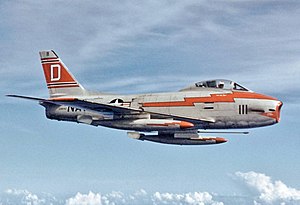North American FJ-3 Fury
| FJ-2 / FJ-3 Fury | |
|---|---|
 |
|
| An FJ-3M of VF-121 Peacemakers in 1957 | |
| Role | Fighter aircraft |
| National origin | United States |
| Manufacturer | North American Aviation |
| First flight | 27 December 1951 |
| Introduction | 1954 |
| Retired | September 1962 |
| Status | Phased out of service |
| Primary users |
United States Navy United States Marine Corps |
| Number built | 741 |
| Developed from | North American F-86 Sabre |
| Developed into | North American FJ-4 Fury |
The North American FJ-2 and FJ-3 Fury were a series of swept-wing carrier-capable fighters for the United States Navy and Marine Corps. The FJ-2 resulted from an effort to navalize the United States Air Force's F-86 Sabre. These aircraft featured folding wings, and a longer nose landing strut designed to increase angle of attack upon launch and to accommodate a longer oleo to absorb the shock of hard landings on an aircraft carrier deck.
Although sharing a U.S. Navy designation with its distant predecessor, the straight-winged North American FJ-1 Fury, the FJ-2/-3 were completely different aircraft. (The later FJ-4 Fury was again, a complete structural redesign of the FJ-3). The FJ-2 was one of the aircraft used to evaluate the first steam catapult on a US Navy aircraft-carrier.
By 1951, the Navy's existing straight-wing fighters were much inferior in performance to the swept-wing Soviet MiG-15 then operating in the Korean War; the swept-wing fighters in the Navy's development pipeline, including the Vought F7U Cutlass and F9F Cougar that were not yet ready for deployment.
As an interim measure, the Navy's Bureau of Aeronautics ordered a direct development of the swept-wing F-86E Sabres as the FJ-2. As the F-86 had not been designed to be carrier-capable, this involved some risk, but Navy pilots had observed that the F-86A actually had a lower landing speed than the F9F Panther. During carrier qualification trials the Navy informed Grumman that if the F9F-5 stall speed was not reduced by 12 mph (10 kn; 19 km/h) it would be removed from carrier operations at the same time that the FJ-2 was already making its debut into Navy squadrons.North American's chief engineer at the time stated that the swept wing Sabre had handling and stall characteristics at low speeds comparable to the best straight winged airplanes. The urgency behind the program was such that 300 (later reduced to 200) FJ-2 fighters were ordered before the prototypes had flown.
...
Wikipedia
